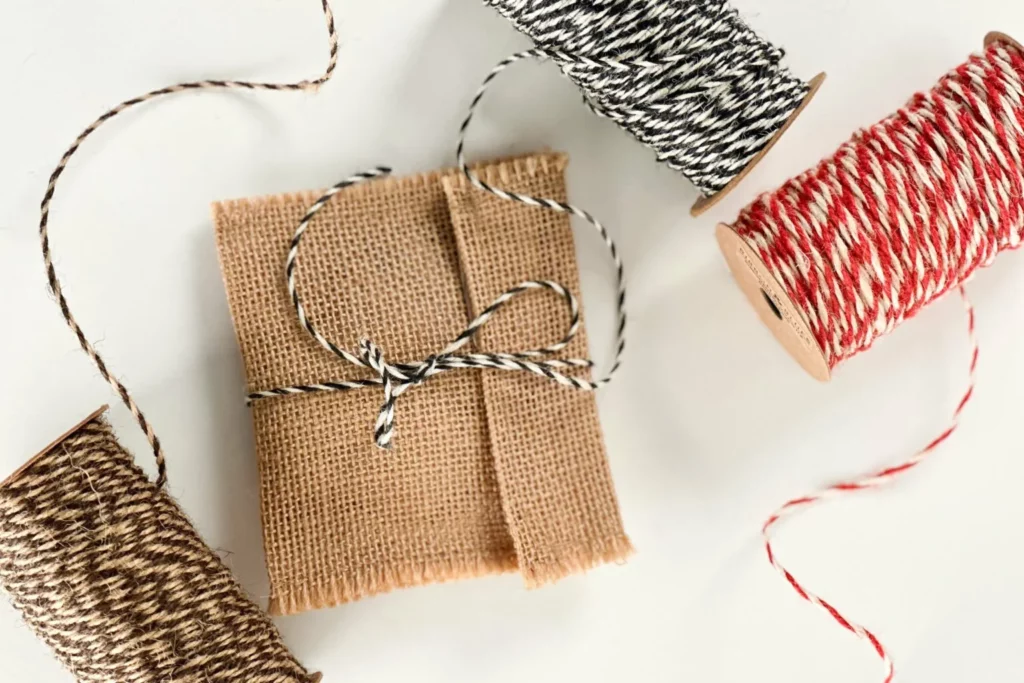Is Jute String Eco Friendly?
What is jute? And, is jute string eco friendly? Jute, a natural fibre derived from the jute plant, has gained immense popularity in recent years. This is due to its eco friendly properties and diverse applications. Among its many uses, jute string and ribbon stands out as an excellent alternative to traditional gift wrapping materials, as can be seen in all of these images. In this blog, we will explore the advantages of jute ribbon, its eco friendliness, and why it is becoming the preferred choice for sustainable gift wrapping.
Understanding Jute Ribbon and Jute String
Jute ribbon is made from jute fibres, which are extracted from the long, soft, and shiny strands found beneath the bark of the jute plant’s stem. Jute ribbon adds a rustic charm to gifts, making them visually appealing and unique. Additionally, this natural material comes in various widths. This means you can easily cut and customise it to suit different gifting sizes.
It is a renewable resource that can be grown without fertilisers and pesticides. It is also biodegradable making it a sustainable choice for ribbons and string. Another key point is that jute is renowned for its strength and durability. In fact, it’s the second most commonly produced plant based fibre!
Advantages of Jute Ribbon and Jute String
1. Eco Friendly: Is jute string eco friendly? It most definitely is! One of the primary reasons for the growing popularity of jute ribbon is its eco friendliness. Jute is a biodegradable and renewable resource. This means it can break down naturally over time, reducing its environmental impact. Additionally, the jute plant requires minimal pesticides and fertilisers. This makes it a sustainable choice.
2. Versatility: Jute ribbon offers incredible versatility. It can be combined with other decorative elements allowing for endless creative possibilities. It’s perfect for wrapping gifts for birthdays, weddings, or festive occasions. Jute ribbon can effortlessly complement any theme or style… not only rustic.
3. Durability: Jute is a sturdy and durable material, but also soft enough to create nice bows or table decorations.
4. Textural Appeal: Jute ribbon’s natural texture adds a unique touch to gifts. Its rustic appearance evokes a sense of authenticity and simplicity. This makes it ideal for those seeking an organic and natural aesthetic.
5. Cost Effective: Compared to some premium gift wrapping options, jute ribbon is relatively cost effective. It offers an affordable yet stylish way to enhance the presentation of your gifts without breaking the bank.
6. Economic Importance of Jute: The jute industry holds significant economic importance for many countries, especially in South Asia, where it is primarily cultivated. India and Bangladesh are among the leading jute producers and exporters. The cultivation of jute provides income and livelihood opportunities for numerous farmers and workers in these regions. Therefore, this contributes to their economic development.
So, Is Jute String Eco Friendly?
Unquestionably, it is! Jute ribbon is a remarkable gift wrapping solution that offers a blend of eco friendliness, charm, and durability. Its biodegradable nature and sustainability make it an excellent choice for environmentally conscious individuals. With its versatility and cost-effectiveness, jute ribbon and jute string has rightfully earned its place as a preferred gift wrapping material. So, the next time you want to add a touch of rustic elegance to your gifts, consider reaching for the eco friendly and delightful jute ribbon!
To conclude, sustainable and eco doesn’t mean boring old sacks! Have a look and shop all jute to try some winter warming styling with an eco approach! We have a large range of jute ribbon, jute string, and some jute bags in stock.
You can also check out our trust icons so you can make an informed eco decision on products. We are committed to sourcing our products sustainably where we can, as caring for the environment is one of our core business values.
Additionally, if you want to learn more about the history of jute and how it is made, click here.






